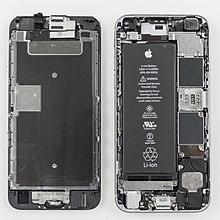Repairability

Only Apple Stores and Apple Authorized Service Providers are allowed by Apple to perform genuine replacements.[127] Apple has taken steps to make third-party repairs more difficult. iPhone components are soldered, and many are glued together.[128] iPhones receive low repairability scores, in part due to the difficulty of obtaining genuine parts, and the difficulty undertaking each repair.[129] This has given rise to the right to repair movement, aimed at giving users cheaper options for repairing their phones. Apple has lobbied against right to repair legislation.[130] Multiple jurisdictions aim to introduce right to repair laws, including the EU,[131] UK,[132] and U.S.[133]
In the past, Apple bricked iPhone 6 models after their home buttons were replaced, displaying an Error 53 message; Apple called this a bug, and released an update to address the issue.[134] On iPhones with a Touch ID sensor, the home button cannot be replaced by users or independent repair shops without losing Touch ID functionality, since Apple has not made their calibration tool public.[135]
Starting with the iPhone XR, Apple displays warnings in the Settings app if the battery, display, or camera are replaced by a third party.[136] Additionally, some features are disabled when a part labeled "non-genuine" is detected, like True Tone, or the battery health measurement. iFixit notes that a proprietary, cloud-linked System Configuration tool is required to "complete" a part repair, meaning that even replacing a genuine part with another genuine part will fail Apple's "genuine parts" check unless said tool is used.[137]
In 2022, Apple rolled out a self-service repair program, allowing any user to buy parts, rent repair tools from Apple, and obtain repair manuals. The program received a degree of praise by iFixit and repair advocates, who also critically noted that Apple maintains control over the parts supply.[138][139]
